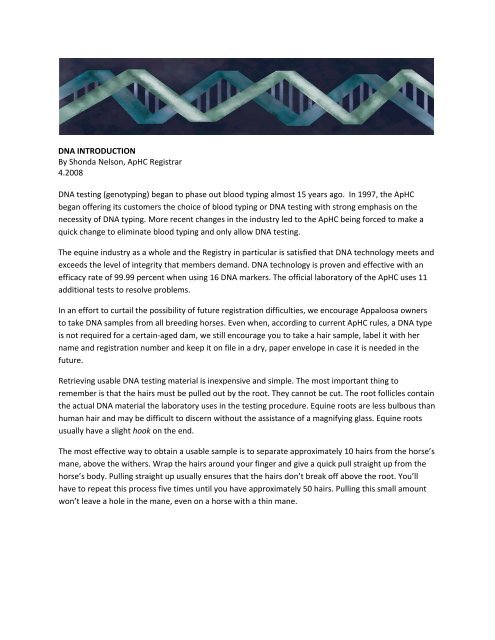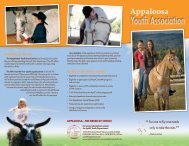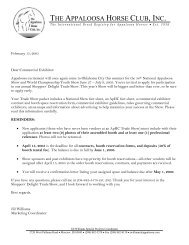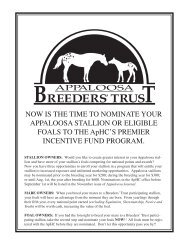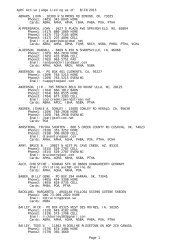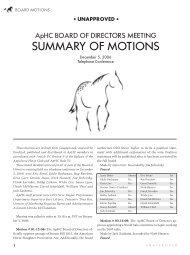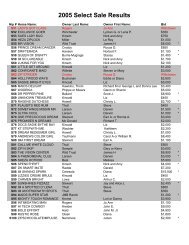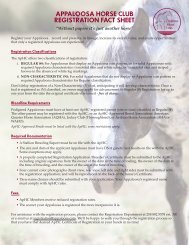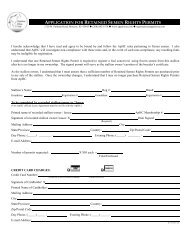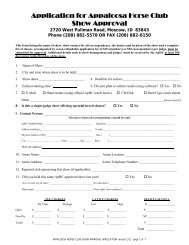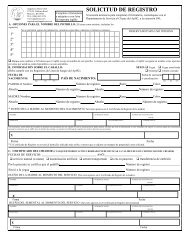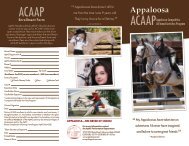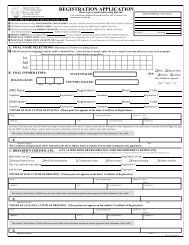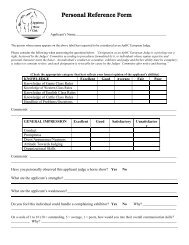dna introduction - Appaloosa Horse Club
dna introduction - Appaloosa Horse Club
dna introduction - Appaloosa Horse Club
Create successful ePaper yourself
Turn your PDF publications into a flip-book with our unique Google optimized e-Paper software.
DNA INTRODUCTION<br />
By Shonda Nelson, ApHC Registrar<br />
4.2008<br />
DNA testing (genotyping) began to phase out blood typing almost 15 years ago. In 1997, the ApHC<br />
began offering its customers the choice of blood typing or DNA testing with strong emphasis on the<br />
necessity of DNA typing. More recent changes in the industry led to the ApHC being forced to make a<br />
quick change to eliminate blood typing and only allow DNA testing.<br />
The equine industry as a whole and the Registry in particular is satisfied that DNA technology meets and<br />
exceeds the level of integrity that members demand. DNA technology is proven and effective with an<br />
efficacy rate of 99.99 percent when using 16 DNA markers. The official laboratory of the ApHC uses 11<br />
additional tests to resolve problems.<br />
In an effort to curtail the possibility of future registration difficulties, we encourage <strong>Appaloosa</strong> owners<br />
to take DNA samples from all breeding horses. Even when, according to current ApHC rules, a DNA type<br />
is not required for a certain‐aged dam, we still encourage you to take a hair sample, label it with her<br />
name and registration number and keep it on file in a dry, paper envelope in case it is needed in the<br />
future.<br />
Retrieving usable DNA testing material is inexpensive and simple. The most important thing to<br />
remember is that the hairs must be pulled out by the root. They cannot be cut. The root follicles contain<br />
the actual DNA material the laboratory uses in the testing procedure. Equine roots are less bulbous than<br />
human hair and may be difficult to discern without the assistance of a magnifying glass. Equine roots<br />
usually have a slight hook on the end.<br />
The most effective way to obtain a usable sample is to separate approximately 10 hairs from the horse’s<br />
mane, above the withers. Wrap the hairs around your finger and give a quick pull straight up from the<br />
horse’s body. Pulling straight up usually ensures that the hairs don’t break off above the root. You’ll<br />
have to repeat this process five times until you have approximately 50 hairs. Pulling this small amount<br />
won’t leave a hole in the mane, even on a horse with a thin mane.
By following the simple instructions printed on the kit ‐‐ placing the roots in the area indicated, taping<br />
the hair shaft to the kit where indicated, folding any long hairs into the kit, and placing the kit in the<br />
included, pre‐addressed envelope ‐‐ your sample should arrive safely at Maxxam Analytics, Inc., the<br />
official laboratory of the ApHC. For more information about Maxxam Analytics, Inc., visit their web site<br />
at http://www.maxxam.ca/. DNA samples should not be submitted to the ApHC.<br />
To order a DNA testing kit, simply click here. To order a DNA and HYPP combination testing kit, simply<br />
click here. Or, contact the ApHC at 208‐882‐5578 ext. 300. Each kit is horse‐specific and great care<br />
should be taken to use the proper kit on the proper horse. Also, care should be taken not to accidentally<br />
mix hairs from two horses in one kit. Doing so will necessitate re‐sampling.<br />
With a 99.99 percent efficacy rate, DNA testing is as close to perfect as you can currently get. However,<br />
there are misconceptions about what these tests can and cannot do.<br />
‐ DNA testing doesn’t measure an <strong>Appaloosa</strong>’s purity.<br />
‐ A foal’s DNA cannot name its sire or dam. It can only verify or exclude a foal as the offspring of its<br />
stated parents.
DNA is a molecule of heredity. The DNA from the sample of the horse that is being tested comes half<br />
from the sire and half from the dam. To parentage verify, the laboratory determines whether the two<br />
parents that have been identified as the sire and dam could combine to produce the foal.<br />
‐ A test for Hyperkalemic Periodic Paralysis, (HYPP) can be completed using the same sample submitted<br />
for DNA typing. HYPP is a muscular disease caused by a hereditary genetic defect that leads to<br />
uncontrolled muscle twitching or profound muscle weakness, and in severe cases may lead to collapse<br />
and/or death. According to research, this condition exists in certain descendants of the stallion<br />
Impressive, AQHA registration number 0767246. The ApHC recommends testing to confirm the presence<br />
or absence of this gene.<br />
2008 ApHC DNA‐Related Rules<br />
1. All stallions by submission of their stallion breeding report for any breeding year must be DNA tested<br />
and the results must be filed with the ApHC.<br />
a. Under a grandfather clause, stallions 10 years old or older as of January 1, 1990, and<br />
breeding five (5) mares or less need not be typed unless they are breeding by artificial<br />
insemination, then the ApHC must have the stallion’s DNA on file.<br />
2. All foals are eligible to be parentage verified and all other horses are eligible to be identified<br />
through DNA testing on the basis of written analysis filed with the ApHC from an ApHCapproved<br />
laboratory, using ApHC‐ approved testing procedures. Upon necessary filings,<br />
such foal’s Certificate of Registration shall be issued or re‐issued with the designation as<br />
“Parentage Verified.” In the event any foal is designated as “Parentage Verified,” no other<br />
method of identification is required under these rules. In the event any other horse is identified<br />
through DNA analysis filed with the ApHC, no other method of identification is required under<br />
these rules. Test results for genetic conditions, if such test(s) is/are drawn from a DNA sample<br />
that is also parentage verified, may be filed with the ApHC and such test results may be<br />
designated on the horse’s Certificate of Registration. All fees and procedures for issuance of<br />
duplicate certificates will be required where applicable.<br />
3. Any horse for which a Performance Permit is sought must be parentage verified through DNA<br />
analysis by an ApHC‐approved laboratory as required by ApHC rules.<br />
4. If a mare is exposed to two or more stallions in less than 45 days, a DNA test of the stallions,<br />
mare and resulting foal will be required before the resulting foal can be registered, with the<br />
owners paying the cost of the testing. If the correct sire cannot be determined as a result of the<br />
testing, the name of each stallion must be given as the sire of any resulting foals and a<br />
breeder’s certificate shall be supplied with respect to the services of each stallion. The charge<br />
for testing will be the actual and necessary cost for performing each test.<br />
5. If a mare is bred naturally and by transported semen within 45 days, resulting foals will be<br />
required to be parentage verified through DNA testing prior to being registered.
6. The ApHC registrar is authorized to randomly and/or selectively require parentage<br />
verification through DNA and/or other genetic testing of ApHC‐registered horses.<br />
7. In addition to other ApHC registration rules, a foal born in a year shown below is not<br />
registerable unless the dam of said foal, born during or after the year shown in the column next<br />
to said foal’s birth year, has filed with the ApHC the results of said mare’s DNA testing<br />
from an ApHC‐approved laboratory using ApHC‐approved testing procedures.<br />
Foal’s Birth Year<br />
Mare’s Birth Year<br />
2004 1995 and after<br />
2005 1994<br />
2006 1993<br />
2007 1992<br />
2008 1991<br />
2009 1990 and prior years<br />
8. The owner of any horse, for which application is made for registration and which cannot be<br />
parentage verified due to unavailability of DNA type of sire or dam, shall have the right to make<br />
written request that the ApHC Registrar consider allowing use of alternative verification<br />
method(s), and the ApHC Registrar, in the Registrar’s sole discretion, may determine that use of<br />
alternative verification method(s) are acceptable to the ApHC in the registration of any such<br />
horse.


